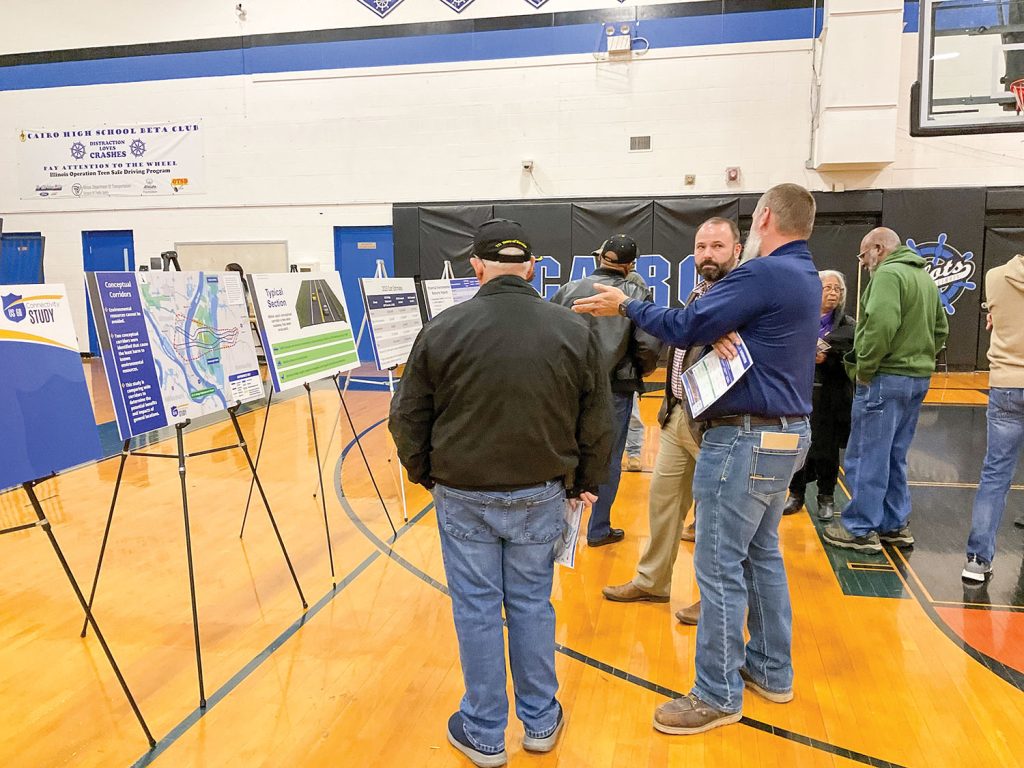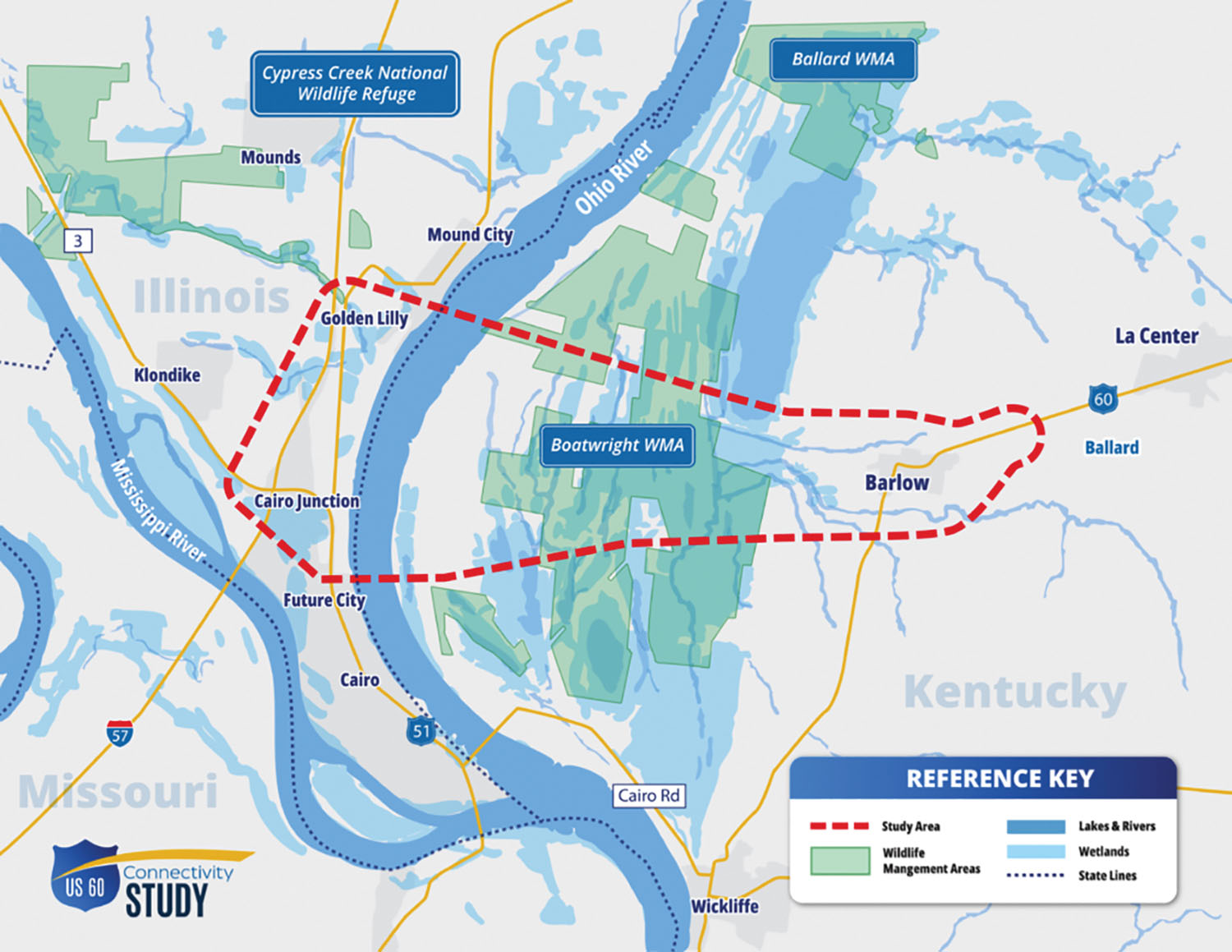Public comments are being sought on moving the planned location of a new Ohio River bridge that would replace the 1936 bridge connecting Wickliffe, Ky., and Cairo, Ill.
The Kentucky Transportation Cabinet originally planned to build a new bridge to carry U.S. 51, U.S. 60 and U.S. 62 immediately upstream from the existing bridge at Ohio River Mile 980.2, but Kentucky lawmakers instead requested the study of a potential alternate crossing. That alternate crossing would bypass Wickliffe and Cairo, extending U.S. 60 in Barlow, Ky., crossing the Ohio approximately 4 miles north of the old bridge, and connecting in the vicinity of Future City, Ill.
Nearly 400 people attended meetings November 29-30 in LaCenter, Ky., and Cairo to express their opinions on the bridge relocation. Public input may also be expressed online through December 30 at US60ConnectivityStudy.com, where more information is also available.
Keith Todd, spokesman for the Kentucky Transportation Cabinet’s district 1 office in Paducah, Ky., said engineering fact-finding is continuing, with the study results expected in early 2024, potentially in time for legislators to consider the results as the next session of the Kentucky General Assembly is gaveled into session in January.
The preliminary engineering estimate for the Barlow-Future City route is $1.2 billion to $1.3 billion, according to a handout provided at the meetings and later posted online. The working budget for building a new Wickliffe-Cairo crossing is roughly $383 million.
“The question is would it be worth the extra investment if this provided improved connectivity and economic development,” Todd said.
State Sen. Danny Carroll, who represents far western Kentucky, said he requested the approximately $2 million study, for which legislators appropriated funds in Kentucky’s 2022 Enacted Highway Plan.
Carroll said, regarding the region’s future, he wondered if a more direct route between Interstate 24 in Paducah and Interstate 57 in southern Illinois might be beneficial.
“Can we justify it today?” Carroll said. “We can’t, but in the decades to come, I think we can justify it.”
Carroll said he also favors a four-lane river crossing, while the Kentucky Transportation Cabinet had advanced a plan for only a two-lane bridge if built between Wickliffe in Cairo, citing current traffic counts.
“That’s a mistake we often make,” he said. “We make a decision based on today. We don’t think about the future.”
Carroll said he has also spoken to Missouri representatives who have told him that it is unlikely the 94-year-old U.S. 60/62 Mississippi River bridge between Cairo and rural Mississippi County, Mo., not far from the Ohio River crossing, will be replaced at the end of its lifespan.
That bridge, built in 1929, closed October 2 for major structural repairs and is not expected to reopen until October 1, 2024. Previously, that bridge underwent a major reconstruction in 1983 and was closed for more than a year beginning in 2011, for seven months beginning in March 2015, and this year from March 23 until late April after bridge inspectors said they found critical issues during a routine inspection.
The Kentucky Transportation Cabinet said the closure of the Mississippi River crossing adds about 4.5 miles to a trip from Wickliffe and from Charleston, Mo., because of the nearby I-57 Mississippi River bridge from southern Illinois into southeast Missouri.
Carroll said relocating the Ohio River bridge would make sense given the location of the I-57 Mississippi River bridge into Missouri and could be useful in drawing a workforce from southeastern Missouri and southern Illinois into Kentucky.

He stressed that, although he requested the study, he will not make up his mind until he sees the results. In particular, Carroll said he wanted to hear from community members, as well as learn how the new crossing would affect wetlands in the study area, many of which are used as hunting property.
“Most of the people I have spoken to have been supportive of this plan, but it’s not about just a few people,” Carroll said. “It’s about the whole community.”
Public radio station WKMS reported after the November 29 meeting that a member of the study’s project team stated the majority of the people he or she had interacted with favor maintaining the Wickliffe-Cairo connection on a new bridge. Many of the more than 300 community members in attendance at the November 29 meeting said the estimated potential travel time difference between the conceptual corridors and the bridge replacement is negligible, and that the corridors’ potential environmental impacts, project cost and economic impact to local businesses were concerning, WKMS reported.
One of the people the radio station reported as being against the new alignment is Angie Yu, president of Two Rivers Fisheries, a Wickliffe-based business that processes and exports invasive carp fished from the Mississippi and Ohio rivers, as well as Kentucky Lake and Lake Barkley. Yu has also been working with Ballard County to develop the Kentucky International Fisheries Park, an industrial development park for related businesses in Wickliffe.
She said the conceptual corridors would “cut off” Wickliffe from potential economic development opportunities, making it difficult to attract more investors as well as to find workers.
Todd said he could not provide information about whether comments received at the meeting were generally in favor of the existing alignment or the new bridge alignment until the study is complete.
Caption for top photoL Map of study area. (Courtesy of the Kentucky Transportation Cabinet)



